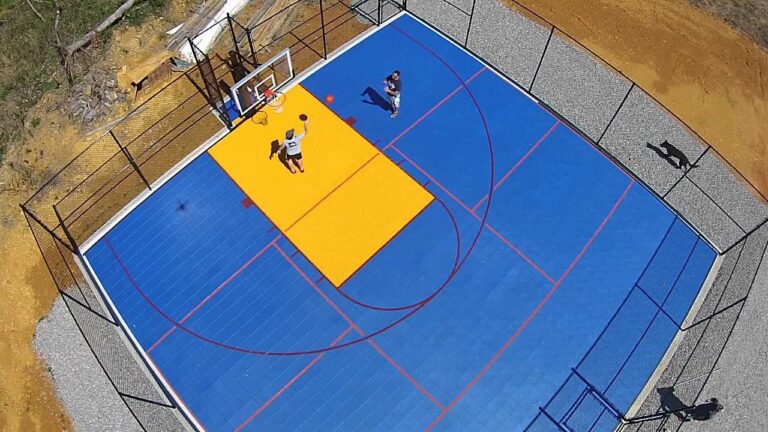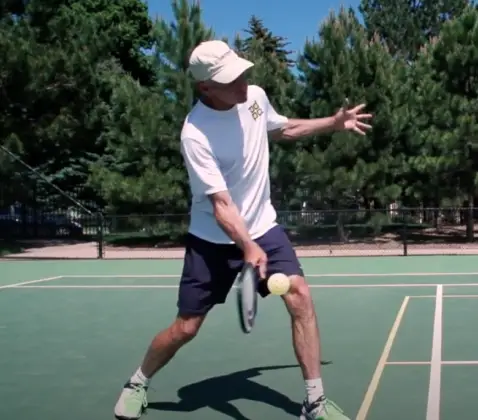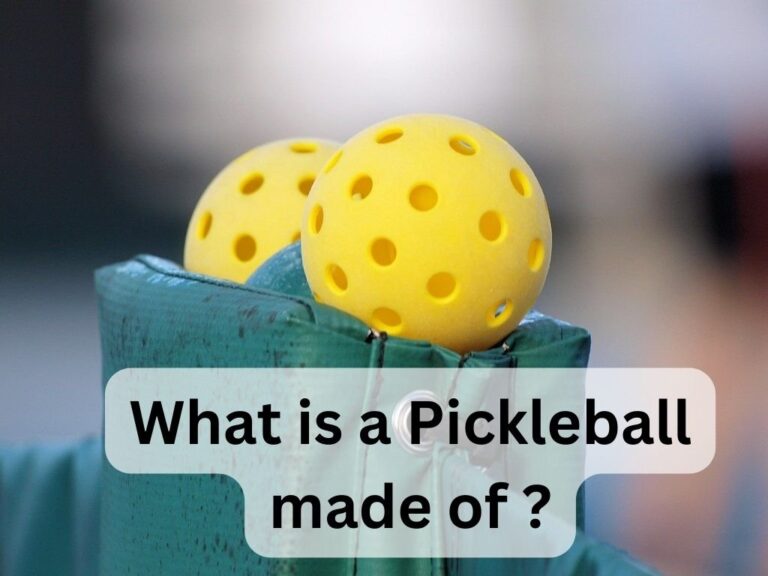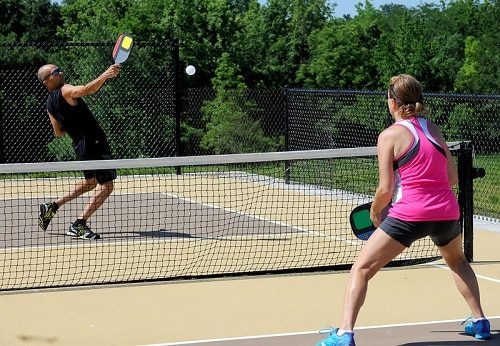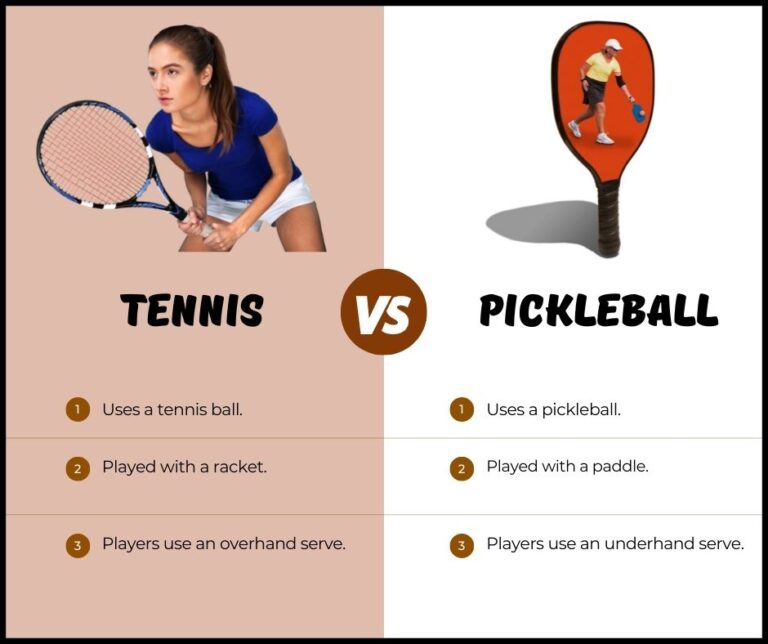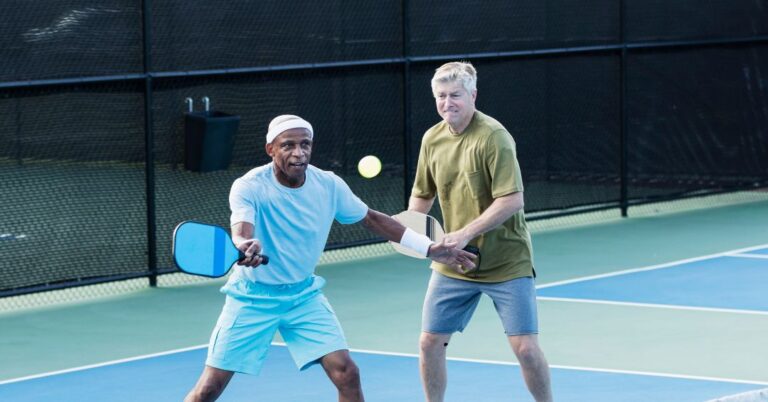Decoding Pickleball Scoring: Tips and Techniques
In pickleball, you only score points when you’re serving. In doubles, scores are announced in three parts: your team’s score, the opponents’ score, and the server number (1 or 2). Indeed, the game starts at 0-0-2 with the second server. You also switch sides after scoring a point. The standard game goes to 11 points with a must-win margin by at least two points. Grasping the server rotation, fault rules and scoring flow is essential to succeed in this game. Stick with us, there’s plenty to learn about strategies and tactics to gain that competitive edge.
Main Points
- Pickleball scoring involves the serving team’s score, receiving team’s score, and server number.
- Only the serving team can score points, with faults resulting in a loss of rally.
- In doubles, the game starts at 0-0-2 with the first server of the match, while in singles, the score involves only two numbers.
- Player rotation and server number changes occur after scoring a point, impacting game flow and strategy.
- A standard pickleball game is played to 11 points, with a win requiring at least a two-point lead.
Understanding Pickleball Scoring
Diving into pickleball scoring, you need to understand that it involves three numbers: the serving team’s score, the receiving team’s score, and server number. This scoring system is unique to pickleball and shapes the flow throughout the game.
When playing doubles, three numbers are announced after each point. For instance, if the first player on the serving team wins a point, the score could be ‘3-2-1’, with ‘3’ being the serving team’s score, ‘2’ the receiving team’s score, and ‘1’ the server number.
In singles, however, only two numbers are used in scoring. The server number is redundant since there’s only one player per side. So, the scoring might be ‘4-3’ instead.
Now, it’s important to remember that points can only be scored by the serving team. If you’re receiving and you win the rally, you don’t score a point; instead, you get the service.
Faults also play a part in pickleball scoring. If you commit a fault, you lose the rally. But don’t worry, points scored before a fault are retained.
The standard game is played to 11 points, and you need to win by at least two points. So, in this fast-paced game, every point counts. Understanding this scoring system is the first step to mastering pickleball.
Score Announcement Rules
When it comes to announcing scores in pickleball, you should always state the serving team’s score first, followed by the receiving team’s score, and finally the server number. This score announcement is an essential part of the game’s mechanics and plays a significant role in progress tracking. For example, if the serving team has 5 points and the receiving team has 4 points, with server number 1 serving, you’d shout out ‘5-4-1’.
Announcing the score isn’t just a formality. It’s a clear way of informing all players and spectators about the current state of the game, bringing clarity and eliminating confusion. Therefore, always remember to shout out the score loud and clear before serving the ball.
After you’ve announced the score, you’ll need to switch sides if you’ve scored a point. This switching of sides is another element that adds to the strategic depth of pickleball. Also, keep in mind that the server number changes after losing a rally. This dynamic nature of the server number and the side-switching rule make pickleball a fascinating and engaging sport to both play and watch.
Server Number Significance
You might be wondering about the importance of the server number in pickleball scoring.
It’s more than just a number; it determines who serves the ball and plays a crucial role in maintaining the correct order and player positions.
Let’s unpack its impact on the overall pickleball score, which is as exciting as the game itself.
Understanding Server Number
Let’s get into the significance the server number plays in pickleball, which indicates who’s serving during a specific service turn. In doubles pickleball, your server number impacts player positioning and rotation. The serving team starts with server number 2, setting the starting score at 0-0-2. This number changes after a fault, signifying a rotation in the serving team. Understanding your server number is essential to keeping score and coordinating your play in a pickleball game.
Here’s a simple table to break it down:
| Server Number | Significance |
|---|---|
| 1 | First to serve in the game |
| 2 | Serves first at the beginning of a game, score starts at 0-0-2 |
| After a fault | Server number changes, indicating rotation |
| Doubles Pickleball | Player positioning and rotation are tied to server number |
| Keeping score | Server number is critical |
Server Number’s Role
In pickleball, the server number plays an essential role in indicating which player on the serving team is up to bat for that particular point. This number, alternating between the two players, maintains order and guarantees fair play. It’s not just about who serves; it’s about player positioning and rotation in doubles pickleball.
Server 1 starts the game serving, and when a fault or lost rally occurs, the serving duties pass to Server 2. This rotation keeps the gameplay dynamic and engaging. Without the server number system, chaos could ensue. So, while you’re mastering your serve or strategizing your next shot, don’t forget the importance of your server number. It’s more than a digit; it’s a critical part of the game.
Impact on Pickleball Score
Having established the role the server number plays, it’s now time to think about how this aspect influences pickleball scoring. In doubles pickleball, the server number, typically 1 or 2, determines who on the serving team is serving. It changes after a fault or side out, playing a key role in the rotation and flow of the game.
You see, understanding the server number is important for player positioning. It guarantees accurate score calling, keeping the game moving smoothly. So, if you want to excel in this sport, mastering the server number’s significance is a necessity. It’s the heartbeat of the game, dictating the rhythm and the score. Remember, a well-played game hinges on the details.
Scoring in Doubles Pickleball
When you’re playing doubles pickleball, you’ll notice that the score consists of three numbers representing the serving team‘s score, the receiving team’s score, and the server number. The game kicks off with a score of 0-0-2. The server number, the third digit, initially is ‘2’, signifying the first server of the match. The serving team delivers a crosscourt serve from the even side of the court.
Player positioning is important as doubles teams rotate sides after each point won. The position depends on whether the total score is odd or even. This strategic rotation maintains the flow of the game while adding a layer in the complexity to the scoring system.
As the game progresses, the score evolves, and the point progression becomes increasingly significant. Each doubles team gets two serves – one for each player, except for the initial serve the match. The serving team has the opportunity to score points until they commit a fault.
In doubles pickleball, understanding the scoring system, adapting to strategic rotations, and mastering the crosscourt serve can give your team a competitive edge. It’s all about teamwork, strategy, and keeping an eye on the score evolution.
Scoring in Singles Pickleball
Unlike doubles, scoring in singles pickleball involves only two numbers: your score and your opponent’s score. As the serving player, your score is always called first, followed by your opponent’s. Your score numbers also determine where you serve from.
When your score is even, you serve from the right-hand court. Conversely, when your score is odd, you serve from the left-hand court. This is one way to keep track score points in singles pickleball.
Remember, only the serving player scores. If you’re the server and you win the rally, you earn a point and continue to serve. If your opponent wins the rally, you don’t score, and it’s their turn to serve.
To make scoring clearer, here is a quick rundown:
- You always call your score first
- Serve from the right-hand court when your score is even
- Serve from the left-hand court when your score is odd
- Only the serving player scores points
- Switch sides with your opponent after each point
With these tips, you’ll be able to easily navigate the scoring system in singles pickleball. Remember, the server number references your specific service turn.
Player Rotation After Scoring
In pickleball, player rotation is a critical part within the game, especially after scoring. It’s all about maintaining balance, ensuring fairness, and giving each player equal opportunities.
You’ll serve from different court positions and even change your server number, all depending upon the score.
Understanding Player Rotation
To understand the concept of player rotation in pickleball doubles, it’s important to know that the serving team switches sides after scoring. This movement isn’t random; it serves a purpose. It guarantees fair play and equal opportunities for both teams.
Here are some key points to remember about player rotation:
- The server who scored the point switches from the right side (even) to the left side (odd).
- Player rotation allows maintaining the accurate positions in the game.
- After scoring a point, the same player continues to serve but from the opposite side.
- Rotation helps in balancing the game dynamics in doubles pickleball.
- Understanding player movement in rotation is essential for strategizing and scoring.
Thus, player rotation is an integral part of pickleball scoring.
Score-Dependent Position Changes
When you’re scoring in pickleball, it’s important to remember that the serving team switches sides on the court. This player rotation is a hallmark of the game, promoting fair play and equal opportunities for both teams.
After scoring a point, the server change takes place, with server 1 becoming server 2, and vice versa. This switch is a strategic move as it enables the team to capitalize on their scoring point.
The player who served the last point will move to the left service court, maintaining a rhythm that guarantees every player gets a turn at serving and receiving. This constant rotation keeps the game dynamic and engaging, ensuring that each point scored is a stepping stone toward victory.
Faults Affecting Scores
Understanding that faults in pickleball can cost you a rally and a scoring opportunity is essential for maintaining a competitive edge. These errors can result from incorrect player positioning, missed serves, or faulty returns. Recognizing them and making necessary faults correction can keep your points intact and help maintain your competitive advantage.
Here are some ways faults can impact your pickleball scoring:
- A fault during your serve forfeits your chance to score during that rally.
- Incorrect player positioning can lead to faults, costing you a scoring opportunity.
- If a fault is detected after points are scored, the rally is lost, but the points are kept.
- A fault on the last point stands unless corrected before the scores are submitted.
- Maintaining a keen eye for faults and making prompt corrections can save your rally and your score.
Non-Serving Team’s Score
In the realm of pickleball, the second number you’ll hear in the score call indicates the non-serving team’s score, representing how many points the opposing team has managed to accumulate. This score is an important piece of information that influences the game’s progress and affects both teams’ strategic decisions.
Being aware of the non-serving team’s score helps you keep track of your team’s standing in the game. The second number in the score call provides you with an accurate depiction of the opposing team’s points. This accuracy is vital to understand where you stand in the competition and what moves you need to make next.
Moreover, the non-serving team’s score offers insight into the opposing team’s strengths and weaknesses. It aids in making strategic decisions that could turn the tide in your favor. For instance, if the non-serving team’s score is relatively low, it might indicate that their serve or return is weak, and you can capitalize on this.
Winning by Two-Point Lead
To secure a win in pickleball, your team must gain a two-point lead over the opponents. This rule, known as the two-point lead, is a critical part in pickleball scoring. It guarantees a clear, decisive victory, eliminating the chance for a tie or a win by a narrow margin. This rule adds an element of strategy to the game, making it more thrilling and competitive.
Using the two-point lead strategy, your goal should be to:
- Keep your opponents on their toes.
- Maintain a steady lead throughout the match.
- Increase your scoring rate without compromising your defense.
- Exploit your opponents’ weaknesses to gain an advantage.
- Stay focused and composed, even under pressure.
Mastering Pickleball Scoring
Nailing down the scoring system in pickleball is essential to your gameplay. You’ve got to understand not just who’s serving and receiving, but also how points are earned and tracked.
Let’s get you up to speed on mastering these points, so you can stay focused on the game.
Understanding Pickleball Points System
Let’s explore the essential points system for pickleball, a key aspect to master for tracking your progress and determining winners in matches. This scoring system is unique and has some specific rules.
In pickleball, points are only scored by the serving team and the game generally ends when a team reaches 11 points, but they must win by a margin of two.
Here are some key aspects regarding the points system:
- The serving team’s score is always called first
- In singles pickleball, only two numbers represent the score
- Only the serving team can score points
- Games are typically played to 11 points but must be won by a margin of two
- The receiving team’s score is called second
Understanding this system helps you track progress and determine the winner effectively.
Tips for Score Keeping
After getting a grip on the points system, you’re ready to master score keeping in pickleball, a skill that can greatly enhance your game strategy.
Always announce the score before serving. This score announcement should include the serving team’s score, opposing team’s score, and server number, in that order.
When a point is won, you switch sides, moving the server to the left service court. The server number changes if a rally is lost.
The scoring progression flows from 0-0-2 to 11 points. In special circumstances, such as at the start the game, you begin at 0-0-2 with server 2.
After losing the first rally, both partners serve before regular gameplay resumes, allowing for a smooth game flow.
Frequently Asked Questions
How Do You Score Pickleball?
To score in pickleball, you’ve got to serve from the correct court. Only the serving team can score, and you must win by at least two points. Announce the score with the server’s score first.
What Does 0-0-2 Mean in Pickleball?
In pickleball, when you hear 0-0-2, it means neither team has scored yet and it’s the second server’s turn. It’s like the starting position in the game, with the second server ready to serve.
How Do You Keep Track of Scores in Pickleball?
You’ll track scores in three parts: your team’s score, the opponent’s score, and server number. After each point, you’ll call out the scores in this sequence. Switch sides after scoring for fairness.
Is Pickleball Played to 11 Points and You Must Win by 2 Points?
Yes, you’re correct. You play to 11 points and must win by 2, ensuring a clear victory. This rule adds a competitive edge, as you’ve got to maintain a 2-point lead to secure your win.
Conclusion
Mastering pickleball scoring might seem complex, but once you’ve got the basics down, it’s a breeze. Remember, only the serving team can score and points are earned through faults.
Whether you’re playing singles or doubles, a two-point lead seals the deal. So, get out there and give it a shot. With practice, you’ll soon be announcing scores like a pro and smashing your way to pickleball victory.
It’s all part of the fun within the game.

